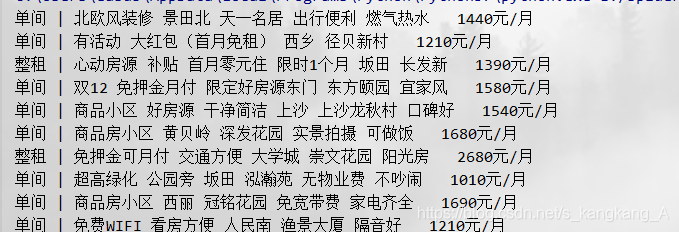58是一个字体反爬相对简单的网站了,它只对数字进行了反爬处理。适合拿来做字体反爬入门。
先上代码,在详细记录,纯小白操作,不怕看不懂啊:
import requests
import base64
import re
from fontTools.ttLib import TTFont
# 获取参数,这里主要是返回的响应内容,及匹配到的font_face被base64编码的文件
def get_params(url):
resp = requests.get(url)
content = resp.text
# print(resp.text)
font_face = re.search("font-face{.*?base64,(.*?)'.*?}", content, re.S).group(1).strip()
# print(font_face)
return font_face, content
# 解base64编码,写入ttf字体文件
def parse_font_face(font_face):
font_face = base64.b64decode(font_face)
with open('58.ttf', 'wb') as f:
f.write(font_face)
font = TTFont('58.ttf')
font.saveXML('58.xml')
# 使用footTools自带的getBestCmap()获取映射
bestcmap = font['cmap'].getBestCmap()
# print(bestcmap)
# 创建新的映射关系字典
newmap = dict()
for key in bestcmap.keys():
value = int(re.search('(\d+)', bestcmap[key]).group(1)) - 1
key = hex(key)
key = re.sub('0x', '&#x', key) + ';'
newmap[key] = value
return newmap
# 根据映射关系,使网页响应内容无乱码
def parse_message(newmap, content):
for key, value in newmap.items():
if key in content:
content = content.replace(key, str(newmap[key]))
titles = re.findall('<h2>.*?<a .*?>(.*?)</a>', content, re.S)
# print(titles)
prices = re.findall('<div class="money">.*?<b .*?>(.*?)</b>', content, re.S)
# print(prices)
# print(len(titles), len(prices))
message = dict()
for i in range(len(titles)):
titles[i] = re.sub('\n| ', '', titles[i])
message[titles[i]] = prices[i] + '元/月'
for k, v in message.items():
print(k, v)
if __name__ == '__main__':
url = 'https://sz.58.com/chuzu/'
font_face, content = get_params(url)
newmap = parse_font_face(font_face)
parse_message(newmap, content)
效果:

然后详细讲一下代码中最重要的部分:
def parse_font_face(font_face):
font_face = base64.b64decode(font_face)
with open('58.ttf', 'wb') as f:
f.write(font_face)
font = TTFont('58.ttf')
font.saveXML('58.xml')
# 使用footTools自带的getBestCmap()获取映射
bestcmap = font['cmap'].getBestCmap()
# print(bestcmap)
# 创建新的映射关系字典
newmap = dict()
for key in bestcmap.keys():
value = int(re.search('(\d+)', bestcmap[key]).group(1)) - 1
key = hex(key)
key = re.sub('0x', '&#x', key) + ';'
newmap[key] = value
return newmap
处理字体文件这个部分。
我们一行一行看:
首先,这个函数传了一个font_face的值,它是在网页中匹配到的base64编码的ttf文件:

2-5行代码分别是解码和写文件。
写完之后的文件,用FontCreator打开:

font = TTFont('58.ttf')
font.saveXML('58.xml')
使用python第三方库fontTools处理ttf文件,并生成一个xml文件,其实这个xml文件在代码里没有作用,主要是为了分析。
打开xml文件:有600行+

我们看到cmap,它就是映射关系,它有多种映射关系,也就是说,它的映射是动态的,而非静态的。也就是说,你用找规律的方式写死映射关系,是不可行的。
它用到的映射关系,会在最上面一个:

我们拿第一行为例:
<map code="0x9476" name="glyph00008"/><!-- CJK UNIFIED IDEOGRAPH-9476 -->
注意:0x9476 glyph00008
我们在看FontCreator打开的文件:

注意:uni9476 7
我们对照多组可以发现,去掉uni和0x,glyph0000:
9476在xml里对应的值,比在ttf文件对应的值,大1
也就是说:
xml:9476 8
ttf :9476 7
所以,后面代码:
bestcmap = font['cmap'].getBestCmap()
获取ttf文件中的cmap映射关系
# 创建新的映射关系字典
newmap = dict()
for key in bestcmap.keys():
value = int(re.search('(\d+)', bestcmap[key]).group(1)) - 1
key = hex(key)
key = re.sub('0x', '&#x', key) + ';'
newmap[key] = value
return newmap
创建一个新的映射关系表:
原有的cmap映射关系,使获取的数字-1,达到我们在FontCreator里看到的映射关系
变成16进制
替换,这一步是为了后面处理网页做的,在开发者模式,看见是这些乱七八糟的字符:

查看网页源码,就变成了16进制,但是,把0x变成了&#x,多了个“;”:

所以要有替换操作。
新的映射关系写入新的映射关系字典。即可。
来源:CSDN
作者:s_kangkang_A
链接:https://blog.csdn.net/s_kangkang_A/article/details/103819284